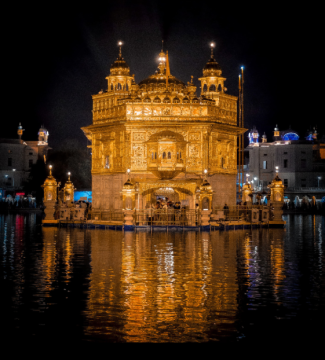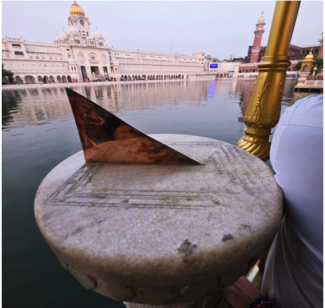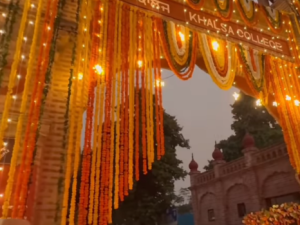Among the many treasures that grace the precincts of the Darbar Sahib, Amritsar, one of the most intriguing yet lesser-known relics is the Sundial, or Sun Clock, located on the bridge that connects the Darshani Deorhi to the sanctum sanctorum (Darbar Sahib). Situated on the left side, about midway along the bridge, this remarkable scientific instrument is not merely a relic of timekeeping—it stands as a symbol of the intellectual and scientific spirit that flourished under the Sikh Empire.
This historic sundial was invented by Sardar Lehna Singh Majithia (1803–1887), one of the most distinguished polymaths of the Sikh period. A scholar, engineer, and astronomer of exceptional intellect, Lehna Singh was celebrated for his wide-ranging contributions to the sciences, from optics and mechanics to time measurement. He presented this ingenious device to Maharaja Ranjit Singh, the sovereign of the Sikh Empire, who, in turn, gifted it to the Darbar Sahib as a symbol of harmony between spiritual devotion and scientific inquiry.
Before the invention of mechanical clocks, humans relied on the position of the sun to tell time. The sundial—an instrument of ancient astronomical significance, operates on this principle. It consists of a flat surface engraved with hour lines and a raised component called the gnomon, which casts a shadow on the dial. The gnomon is fixed at an angle equal to the latitude of the location, in this case, that of Amritsar and points towards the geographic North. As the sun moves across the sky, the shadow cast by the gnomon shifts accordingly, indicating the time of day.(Photo Credits: Taranjot Singh Sarna)
The Darbar Sahib sundial follows this traditional design with remarkable precision. Despite the passage of nearly two centuries, the instrument continues to function, testifying to the craftsmanship and scientific acumen of its creator.
The presence of this sundial within the sacred precincts of the Darbar Sahib also reflects the Sikh Empire’s enlightened approach toward science and knowledge. Maharaja Ranjit Singh’s court was home to scholars, astronomers, and engineers who contributed to both practical and theoretical sciences. Sardar Lehna Singh Majithia stood at the forefront of this movement, demonstrating that Sikh intellectualism embraced both spiritual and empirical understanding.
Today, the sundial remains an overlooked yet invaluable artifact, quietly narrating the story of a time when science and faith coexisted in harmony. It is situated along the marble bridge connecting the parkarma (outer circumambulation path) to the sanctum, where countless devotees pass daily—often unaware of its profound historical and scientific significance.The preservation of this instrument is of great importance, not only as a piece of heritage but as a reminder of Punjab’s scientific and cultural renaissance under the Sikh Empire. It stands as a tangible link to the intellectual curiosity that defined Sikh civilization during its golden age.
The Sundial at the Darbar Sahib is more than a timekeeping device—it is a monument to the synthesis of science, art, and spirituality. Created by a visionary mind and enshrined in the most sacred Sikh shrine, it embodies the Sikh ethos of learning, observation, and reverence for divine order in nature. Ensuring its recognition and preservation would honor both the scientific genius of Sardar Lehna Singh Majithia and the enlightened legacy of Maharaja Ranjit Singh’s reign.
(Photo Credits: Taranjot Singh Sarna)








